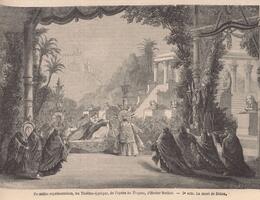Les Troyens

Though apparently impetuous, Berlioz in fact let his projects mature for many years before actually composing them. He had been keenly interested in Virgil's epic poem The Aeneid since his teenage years and first began to think of using it as inspiration for a stage work in 1851. Five years later, encouraged by Princess Carolyne zu Sayn-Wittgenstein, he began work on Les Troyens, which he completed in 1858, but he continued to make additions until 1864. Excerpts from Acts I and IV were presented in concert form in 1859 at the Baden-Baden Festival, but Berlioz did not live to see his score performed in its entirety, the Paris Opéra having turned it down on the grounds that the production was likely to be too costly. In 1863 Léon Carvalho, the director of the smaller Théâtre-Lyrique, agreed to stage the second half of the opera (Acts III, IV and V) with the title Les Troyens à Carthage (The Trojans in Carthage). The first part, La Prise de Troie (The capture of Troy) (Acts I and II), was premièred ten years after Berlioz’s death by Pasdeloup at the Cirque d’Hiver and Colonne at the Théâtre du Châtelet on the same day, 7 December 1879. Felix Mottl conducted the first complete staged performance of Les Troyens, on 6 December 1890 at the Hoftheater in Karlsruhe, where it was sung in German. It is no coincidence that this opera, unusual in its dimensions, was taken up by a conductor who worked regularly at Bayreuth and had participated in the creation of the Ring Cycle. But Les Troyens is also an extraordinary work in its original synthesis of tragédie lyrique and grand opera, and in the way it alternates the grandiose and the intimate. There is originality in Berlioz’s use of the instruments: listen, for example, to how the clarinet in the Pantomime d’Andromaque conveys the mood of Hector’s widow, and how the Chasse royale et orage at the beginning of Act IV resembles a symphonic poem.




